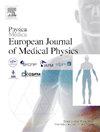Proton therapy of lung cancer patients – Treatment strategies and clinical experience from a medical physicist’s perspective
IF 3.3
3区 医学
Q1 RADIOLOGY, NUCLEAR MEDICINE & MEDICAL IMAGING
Physica Medica-European Journal of Medical Physics
Pub Date : 2025-02-01
DOI:10.1016/j.ejmp.2024.104890
引用次数: 0
Abstract
Purpose
Proton therapy of moving targets is considered a challenge. At Maastro, we started treating lung cancer patients with proton therapy in October 2019. In this work, we summarise the developed treatment strategies and gained clinical experience from a physics point of view.
Methods
We report on our clinical approaches to treat lung cancer patients with the Mevion Hyperscan S250i proton machine. We classify lung cancer patients as small movers (tumour movement ≤ 5 mm) or large movers (tumour movement > 5 mm). The preferred beam configuration has evolved over the years of clinical treatment, and currently mostly two or three beam directions are used. All patients are treated with robustly optimised plans (5 mm setup and 3% range uncertainty). Small movers are planned based on a clinical target volume (CTV) with a 3 mm isotropic margin expansion to account for motion, while large movers are planned based on an internal target volume (ITV). All patients are treated in free-breathing.
Results
Between October 2019 and December 2023, 379 lung cancer patients have been treated, of which 130 were large movers. The adaptation rate was 28%. The median treatment time has been reduced from 30 to 23 min. The mean dose to the heart, oesophagus, and lungs was on average 4.3, 15.4, and 11.0 Gy, respectively.
Conclusions
Several treatment planning and workflow improvements have been introduced over the years, resulting in an increase of treatment quality and number of treated patients, as well as reduction of planning and treatment time.
肺癌患者的质子治疗-从医学物理学家的角度看治疗策略和临床经验。
目的:移动靶的质子治疗被认为是一个挑战。在Maastro,我们于2019年10月开始用质子治疗肺癌患者。在这项工作中,我们从物理学的角度总结了发展的治疗策略和获得的临床经验。方法:报告Mevion Hyperscan S250i质子机治疗肺癌患者的临床方法。我们将肺癌患者分为小移动者(肿瘤移动量≤5mm)和大移动者(肿瘤移动量≤5mm)。在多年的临床治疗中,首选的光束配置已经演变,目前主要使用两个或三个光束方向。所有患者均采用稳健优化方案(5毫米设置和3%范围不确定性)进行治疗。小型移动器是根据临床靶体积(CTV)计划的,具有3毫米各向同性边缘扩展以考虑运动,而大型移动器是根据内部靶体积(ITV)计划的。所有患者均接受自由呼吸治疗。结果:2019年10月至2023年12月,共治疗379例肺癌患者,其中130例为大移动者。适应率为28%。中位治疗时间从30分钟减少到23分钟。心脏、食道和肺的平均剂量分别为4.3、15.4和11.0 Gy。结论:多年来引入了多项治疗计划和工作流程的改进,提高了治疗质量和治疗人数,减少了计划和治疗时间。
本文章由计算机程序翻译,如有差异,请以英文原文为准。
求助全文
约1分钟内获得全文
求助全文
来源期刊
CiteScore
6.80
自引率
14.70%
发文量
493
审稿时长
78 days
期刊介绍:
Physica Medica, European Journal of Medical Physics, publishing with Elsevier from 2007, provides an international forum for research and reviews on the following main topics:
Medical Imaging
Radiation Therapy
Radiation Protection
Measuring Systems and Signal Processing
Education and training in Medical Physics
Professional issues in Medical Physics.

 求助内容:
求助内容: 应助结果提醒方式:
应助结果提醒方式:


